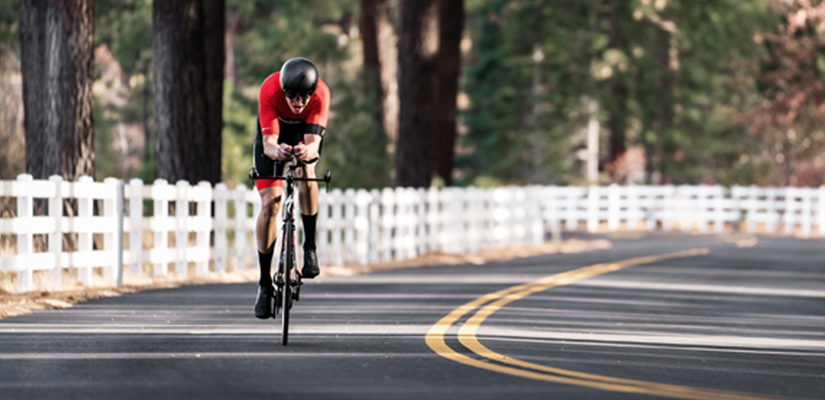I’ve Never Done My Full Race Distance — Will I Be Ready for My Event?

Faced with a long-distance race but aren’t sure you have the fitness you need? You may be surprised to learn that you can tackle long-distance races (and rides) with all the fitness you need, and more, by simply training smart.
How the Time-Crunched Athlete Gets Faster
The problem many athletes face is the limiting belief that they can’t get faster with the little training time they have available in their busy lives. Take a breath, and take solace in the fact that you don’t have to ride for inordinate amounts of time to be competitive for your long-distance events and rides. Even ultra-endurance athletes efficiently build their fitness under time constraints by integrating progressive, structured training into their training plans.
Why You Don’t Need to Train for X Minutes to be able to Ride for X Minutes
Cycling endurance training has typically been thought of as long, gruelling hours on the bike. It seems obligatory to go out and train for the same distance that we’ll face in our races. Simply put, you don’t need to. Sports science and enhanced understanding of physiology brings to light that high-intensity interval training elicits the same training stimulus necessary to prompt physiological adaptations in cyclists to get faster. TrainerRoad training plans are built around these principle advancements in sports science. Let’s see … grind out lower intensity miles for long durations, or train efficiently on a time budget with higher-intensity interval training?
High-intensity interval training isolates specific energy systems to prompt specific physiological responses. TrainerRoad’s guided training allows riders to target the right training impulses and see increased fitness, without having to do the longer duration rides that are normally associated with this sort of fitness gain. In a progressive approach to training, we can’t continually task our bodies with event-distance training. Not only is it unnecessary, it has potential to be a detriment to your training progression in the long-run. So, what about the mental hurdles?
Mental Barriers: How to Get Over Them
Every rider faces a mental barrier of conquering that first long ride; whether that’s the first 50 miler, or even the first go at a 112 mile bike-leg at a Full-Distance triathlon. It’s intimidating, and our natural inclination is to train by taking to the road with something like 4 bottles and our pockets stuffed with food. We’ve all been there, and maybe that’s where we’re at right now. That isn’t the best approach.
Another tendency is to doubt our training when we see there aren’t any 50 mile or 112 mile efforts in our training plan. This is natural, intended in our training plan design, and also something we have an explanation for: Athletes can build the fitness necessary to be competitive at their events without having ever done the distance that they’ll compete at. Fitness isn’t the concern, but for other reasons we do recommend getting out on the road as you approach your event(s).
Reasons to Train Longer for a Long-Distance Event
Racing requires highly specific forms of fitness. The type of fitness we spend our entire training season building up towards. Training is specialized during what is known in the TrainerRoad training plan process as the Specialty Phase of training. The final training phase that leads you to your event. Throughout this phase of training is a perfect time to experiment on the road with some longer rides (not necessarily the same distance/time of your event).
- Test hydration and nutrition strategy: You don’t want GI issues when it comes time for the big day. Test your nutrition and hydration needs when you put your high-end fitness to the road.
- Familiarize aero positioning for an extended period of time: That fancy bike isn’t worth a darn if you’re riding upright for half your race.
- Test ride your course: If you have the option, pre-ride portions of your course to pick up on any nuances there may be. It doesn’t take your race-day effort to get familiar with your course.
- The fun factor: You may just want to get out on the road while following a high-intensity interval training plan. We feel you, and want athletes to feel comfortable and stay motivated by getting outside when it’s needed. Our training plans include longer weekend rides that are perfect to be swapped out for a ride in the great outdoors. It may not lend itself to your fitness as much as a ride on the trainer would, but we have to remind ourselves we do enjoy this.
For more cycling training knowledge, listen to the Ask a Cycling Coach — the only podcast dedicated to making you a faster cyclist. New episodes are released weekly.
References
- Gibala, et al., (2006, September), Short-term sprint interval versus traditional endurance training: similar initial adaptations in human skeletal muscle and exercise performance. https://www.ncbi.nlm.nih.gov/pubmed/16825308
- Nalcakan, G. R., (2014, December), The Effects of Sprint Interval vs. Continuous Endurance Training on Physiological And Metabolic Adaptations in Young Healthy Adults. https://www.ncbi.nlm.nih.gov/pubmed/25713670
- Gillen, J. B., Gibala, M. J., (2014, March), Is high-intensity interval training a time-efficient exercise strategy to improve health and fitness? https://www.ncbi.nlm.nih.gov/pubmed/24552392
- Burgomaster, et al., (June, 2005), Six sessions of sprint interval training increases muscle oxidative potential and cycle endurance capacity in humans. https://www.ncbi.nlm.nih.gov/pubmed/15705728
- Tabata, I., et al., (October, 1996), Effects of moderate-intensity endurance and high-intensity intermittent training on anaerobic capacity and VO2max. Medicine and Science in Sports and Exercise https://www.ncbi.nlm.nih.gov/pubmed/8897392
- Billat, L.V., (2001), Interval training for performance: a scientific and empirical practice. Special recommendations for middle- and long-distance running. Part I: aerobic interval training. https://www.ncbi.nlm.nih.gov/pubmed/11227980
- Cocks, et al., (February, 2013), Sprint interval and endurance training are equally effective in increasing muscle microvascular density and eNOS content in sedentary males. https://www.ncbi.nlm.nih.gov/pubmed/22946099
- Foster, et al., (2015, December), The Effects of High Intensity Interval Training vs Steady State Training on Aerobic and Anaerobic Capacity https://www.ncbi.nlm.nih.gov/pmc/articles/PMC4657417/